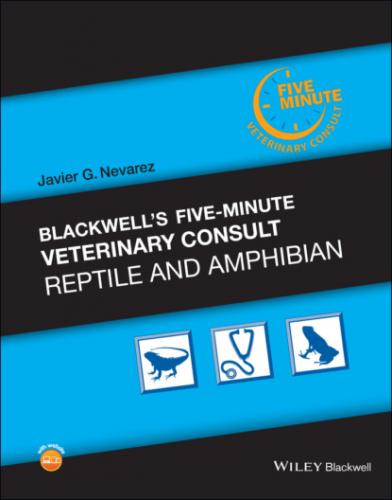COMMENTS
N/A
ZOONOTIC POTENTIAL
N/A
SYNONYMS
N/A
INTERNET RESOURCES
Veterinary Information Network: www.vin.com
Suggested Reading
1 Casimire‐Etzioni AL, Wellehan JF, Embury JE et al. Synovial fluid from an African spur‐thighed tortoise (Geochelone sulcata). Vet Clin Path 2004;33(1):43–46.
2 Dallwig R. Allopurinol. J Exot Pet Med 2010;19(3):255–257.
3 Mader DR. Gout. In: Mader DR, ed. Reptile Medicine and Surgery. 2nd ed. St. Louis, MO: Elsevier Saunders; 2006:374–379.
Author Joanna Hedley, BVM&S, DZooMed (Reptilian), DECZM (Herpetology), MRCVS
Hepatic Lipidosis
DEFINITION/OVERVIEW
Hepatic lipidosis is the excessive accumulation of triglycerides in the hepatocytes and can result in altered hepatic function. It is expected to be a reversible lesion if the underlying cause is corrected. It is a common lesion diagnosed in reptiles.
ETIOLOGY/PATHOPHYSIOLOGY
Triglyceride accumulation in hepatocytes can occur due to disturbances of lipid metabolism from primary metabolic liver disease, toxins, protein malnutrition, diabetes mellitus, obesity, anorexia (increased fatty acid mobilization from peripheral stores), extrahepatic visceral inflammation, and anoxia (inhibits fatty acid oxidation).
In female reptiles, the change can be associated with folliculogenesis.
The common factor for each of these possible etiologies is a negative balance between the rates of deposition and dispersal of fat from the liver, resulting in an accumulation of triglycerides in the liver.
In reptiles, obesity from rich diets can result in hepatic lipidosis and enlargement of the coelomic fat bodies.
Reduced activity will also contribute to increased fat deposits and is not uncommonly reported condition in monitors and turtles.
In tortoises, a lack of normal hibernation and reproductive activity can lead to hepatic lipidosis.
SIGNALMENT/HISTORY
Hepatic lipidosis is reported to be more common in turtles. Data from one laboratory (D Reavill, unpublished) found the percentages of hepatic lipidosis in the reptile groups with the liver submitted for evaluation, as follows:chelonians (turtles and tortoises) (97/676) 14%lizards (304/1485) 20%snakes (91/1672) 5.4%
There is a reported difference in tolerance to the condition, with turtles being more resistant to metabolic derangements.
CLINICAL PRESENTATION
The clinical signs are generally non‐specific.
Signs include weakness, depression, pale oral mucous membranes, and non‐specific neurologic signs.
Green to blue urates are reported, and clay‐like, tan, or watery feces may also be noted.
RISK FACTORS
Husbandry
Inappropriate diet and overfeeding, such as chelonians fed only canned dog food.
Chronic stress: inappropriate captive husbandry conditions (POTZ, cage size, feeding strategies).
Inactivity: restricted physical activity due to space or adequate stimulation.
Inappropriate support for reproduction
Inappropriate hibernation conditions
Anorexia/hyporexia: desert and sulcata tortoises that have failed to eat for more than 1 week.
Others
N/A
Although the presumptive diagnosis is based on history, clinical signs, laboratory data, and imaging, the definitive diagnosis is made by microscopic evaluation of a liver biopsy or necropsy examination.
DIFFERENTIAL DIAGNOSIS
Hepatic lipidosis needs to be distinguished from other causes of hepatomegaly.
Vascular congestion: underlying cardiovascular disease.
Toxins: mycotoxins, pesticides, heavy metals
Infectious diseases: herpesvirus, adenovirus, Salmonellaspp., mycobacteria, Gram‐ negative bacterial infections, abscesses/ granulomas, protozoa.
Tumor: lymphoma, hepatoma
DIAGNOSTICS
Imaging
Radiographs ± contrast, ultrasound, CT, and MRI.
There may an enlarged hepatic silhouette on radiography.
Ultrasound may reveal a brightly reflective, enlarged, rounded liver.
CT provides measurements of radiodensity of the liver.
CT values lower than 20 HU are compatible with hepatic lipidosis in red‐footed tortoises (Chelonoidis carbonaria).
Hematology and Biochemistry
Serum biochemistry: lack of species‐specific reference ranges make interpretation challenging.
In general, decreased plasma proteins; increased triglycerides, cholesterol, AST, and LDH; glucose and bile acid levels vary; blood is often noticeably lipemic.
PATHOLOGICAL FINDINGS
The gross appearance is of an enlarged, friable liver, pale tan to yellow, and typically has a greasy feel.
Biopsy and/or necropsy histopathology: the hepatocytes will be variably enlarged, and supporting cytoplasmic vacuolization with HE stain.
Additional stains will demonstrate the prominent oil red O‐positive lipid droplets in all the hepatocytes.
APPROPRIATE HEALTH CARE
Administration
